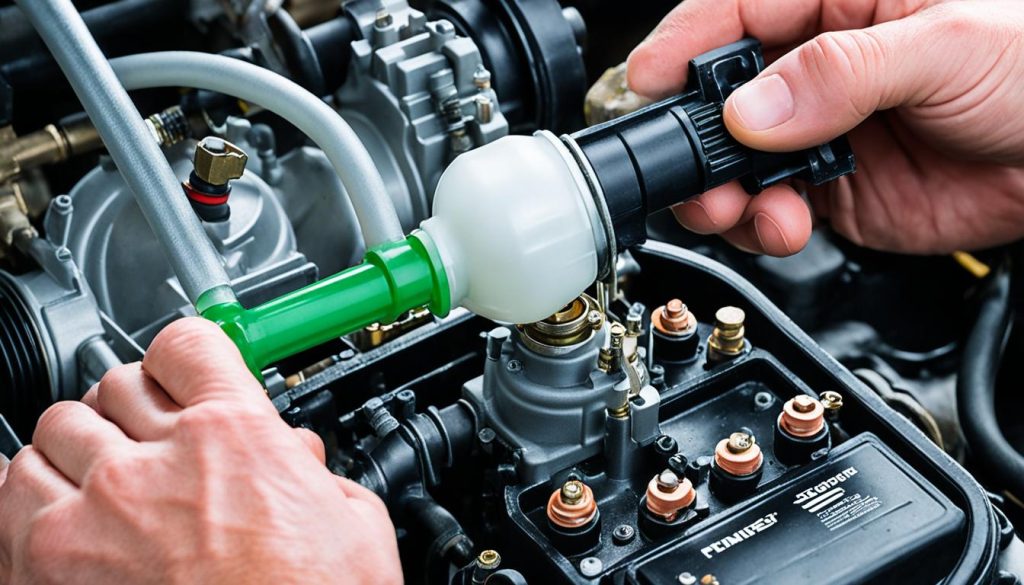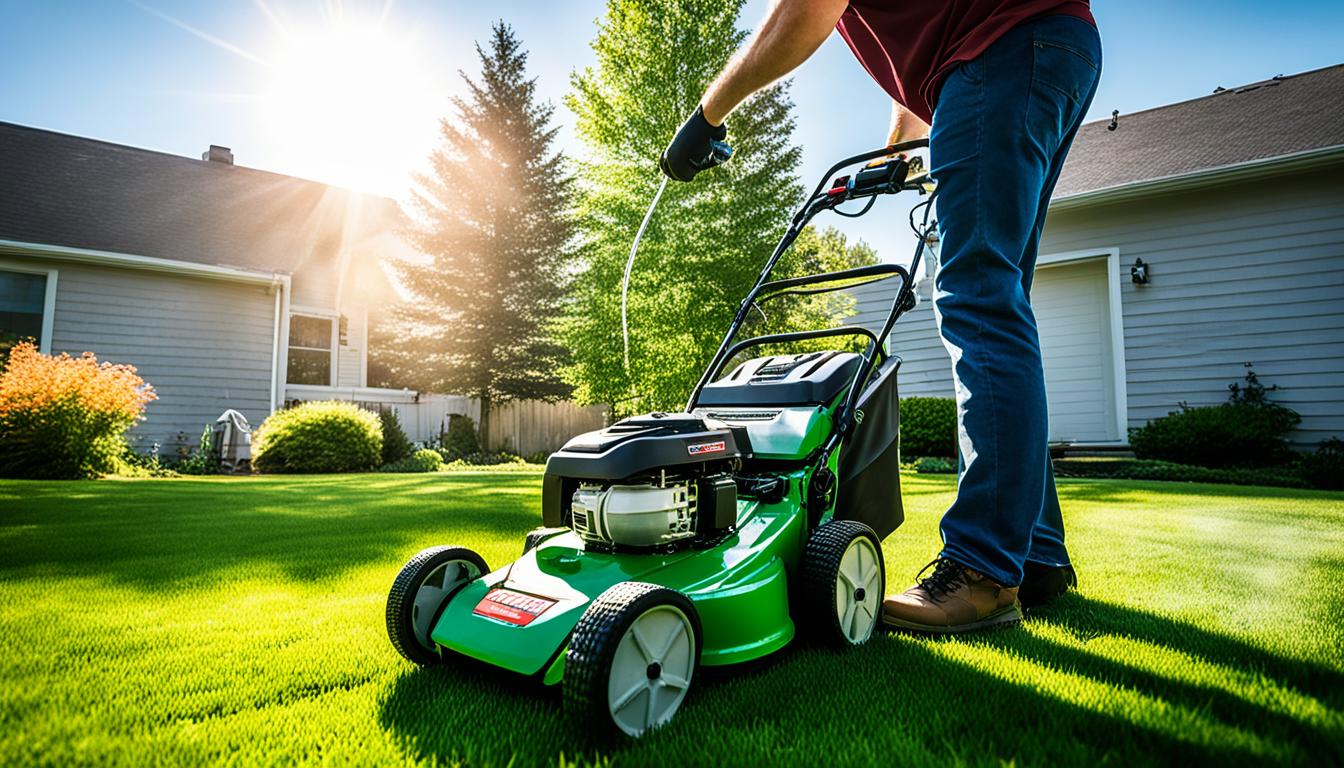Are you tired of wrestling with your lawn mower every time you need to get it started? Do you feel like you’re missing some vital information that could make the process easier? Look no further – this article is here to provide you with all the tips and tricks you need to start your lawn mower with confidence.
Starting a lawn mower may seem like a simple task, but many people struggle with it. From preparing the mower to troubleshooting common issues, there are several steps involved in getting your mower up and running.
So, how can you ensure a smooth start for your lawn mower? What are the essential steps you need to take to avoid common pitfalls? Let’s dive in and explore the expert techniques and starting tips that will have your mower roaring to life in no time.
Key Takeaways:
- Preparing your lawn mower by clearing debris and checking fuel and oil levels is crucial for a smooth start.
- Checking the spark plug and priming the carburetor are important steps in getting your mower ready to go.
- Pulling the starter cord with the right technique is vital for starting the lawn mower effectively.
- Troubleshooting common starting issues and performing regular maintenance can help prevent future difficulties.
- Make sure to properly fill the gas tank and consult the user manual for the correct type of fuel.
Preparing to Start the Lawn Mower
Before starting the lawn mower, it’s essential to prepare it properly. Here are some key steps to follow:
- Move the mower to an open, grassy area: Find a suitable spot to start the mower where there is enough space for maneuvering. This will help prevent any accidents or damage to surrounding objects.
- Clear away debris: Take a few minutes to inspect the area and remove any debris, such as fallen branches or rocks, that could interfere with the mower’s blades. This will ensure safe and efficient operation.
- Check fuel and oil levels: It’s important to have sufficient fuel and oil in the mower before starting it. Check the fuel tank and add fuel if necessary. Similarly, inspect the oil level and top it up if needed. Refer to the mower’s user manual for the correct oil type and the recommended oil level.
- Consider the correct fuel-oil ratio for 2-stroke engines: If your mower has a 2-stroke engine, mix the oil with the gas in the correct ratio. Follow the manufacturer’s instructions to ensure proper engine lubrication and performance.
- Securely attach the spark plug: The spark plug plays a crucial role in starting the mower. Before starting, make sure the spark plug is securely attached. It’s advisable to have the spark plug checked and potentially replaced annually for optimal performance.
Why Is Preparing Your Lawn Mower Important?
Proper lawn mower preparation is vital for several reasons. Firstly, moving the mower to a safe and open area reduces the risk of accidents or damage to objects in its path. Secondly, clearing away debris helps prevent the blades from getting jammed, ensuring smooth and efficient operation. Additionally, checking the fuel and oil levels ensures that the mower has enough resources to run. Finally, securely attaching the spark plug and considering regular maintenance helps maintain the mower’s performance and prolong its lifespan.
Checking and Priming the Carburetor
Before starting the lawn mower, it’s important to check the spark plug. Ensure that it is securely attached and consult the user manual if it needs to be repaired or replaced. If your mower has a prime button, push it several times to force the gasoline into the fuel lines. If your mower doesn’t have a prime button, skip this step. Adjust the throttle to a mid-to-high position to allow the engine to keep running once started.
Checking the spark plug is a crucial step in ensuring proper ignition. Make sure the spark plug is securely connected to the engine. If it appears worn or damaged, refer to the user manual for instructions on how to replace it. A faulty spark plug can prevent the mower from starting or cause it to run poorly.
If your lawn mower has a prime button, locate it on the engine and press it several times. This action will force gasoline into the carburetor, making it easier to start the mower. However, not all mowers have a prime button, so if yours doesn’t, you can skip this step.
Next, adjust the throttle to a mid-to-high position. The throttle controls the amount of fuel and air mixture entering the engine. A mid-to-high throttle setting allows the engine to run smoothly once started. Refer to the user manual to locate and adjust the throttle on your specific mower model.

Summary Table: Checking and Priming the Carburetor
| Step | Description |
|---|---|
| Check the spark plug | Ensure it is securely attached and replace if necessary |
| Prime the carburetor | Push the prime button multiple times (if applicable) |
| Adjust the throttle | Set it to a mid-to-high position for smooth engine operation |
Starting the Lawn Mower
To start the lawn mower, follow these steps:
- Hold the horizontal lever near the handle against the handle itself.
- Grip the handle of the starter cord and pull upward quickly and firmly.
- Repeat the pulling motion several times if the motor doesn’t start immediately.
If the mower still doesn’t start or make any noises, troubleshooting may be required. Here are some common starting issues and their solutions:
Troubleshooting Starting Issues
| Issue | Solution |
|---|---|
| Spark plug or fuel level check | Inspect the spark plug for any damage or dirt. Clean or replace it if necessary. Also, ensure the fuel level is sufficient for the mower to run. |
| Stuck starter | Clear out any debris that may be obstructing the starter mechanism. Debris in the mower deck can cause the starter to get stuck. |
| Smoking mower | If the mower is smoking, allow it to cool off before investigating further. Check for clogged air filters or bent blades which could be causing the issue. |
By troubleshooting these starting issues, you can improve the chances of your lawn mower starting successfully. Remember to always refer to the user manual for specific instructions and consult a professional if needed.
Troubleshooting Common Starting Issues
If your lawn mower won’t start, it can be a frustrating situation. However, there are several common issues you can troubleshoot to get your mower up and running again. By following these troubleshooting steps, you can diagnose and resolve the starting problems with your lawn mower.
1. Check the Gas Tank
The first thing to check when your lawn mower won’t start is the gas tank. Make sure it is filled with fresh gasoline and not contaminated with dirt or water. Old or stale gas can also prevent the engine from starting. If the gas is old or contaminated, drain the tank and refill it with fresh fuel.
2. Examine the Spark Plug
The spark plug is an essential component in starting the lawn mower’s engine. Inspect the spark plug for any damage or dirt buildup. If it is dirty or fouled, clean it using a wire brush or replace it if necessary. A faulty spark plug can prevent the engine from igniting and starting.
3. Clear Debris from the Mower Deck
If there is debris, such as grass clippings or twigs, clogging the mower deck, it can hinder the blades from turning and starting the mower. Clear any debris from the deck using a brush or a garden hose. This will ensure that the blades can rotate freely, enabling the mower to start properly.
4. Check the Air Filter
The air filter is responsible for filtering out dirt and debris from the air that enters the engine. A clogged air filter can restrict airflow, making it difficult for the engine to start. Inspect the air filter and clean or replace it if necessary. A clean air filter will improve airflow and help the mower start more easily.
5. Consult a Professional
If you have tried troubleshooting the common starting issues and your lawn mower still won’t start, it may be time to seek professional assistance. A qualified technician will have the expertise and tools to diagnose and fix any underlying problems with your mower’s engine. They can provide further guidance and ensure that your lawn mower is in proper working condition.
By addressing these common starting issues and following the troubleshooting steps, you can increase the chances of getting your lawn mower to start successfully. Remember to regularly maintain your mower to avoid future starting problems, and consult a professional if you need additional help.
Checking and Changing the Motor Oil
Regularly checking the motor oil in your lawn mower is crucial for its optimal performance and longevity. By maintaining the correct oil level and changing the oil periodically, you can ensure that your lawn mower runs smoothly and efficiently.
To check the oil level, locate the cap on the top of the mower body labeled “oil” or with a picture of an oilcan. Unscrew the cap and use the dipstick attached to measure the oil level. The dipstick usually has indicators that show the optimal oil level range. If the oil level is below the fill line, it’s time to add more motor oil.
When adding motor oil, make sure to use the recommended type for your lawn mower. Consult the user manual or the manufacturer’s guidelines to determine the appropriate oil viscosity and grade. It’s important to select high-quality oil that meets the specifications of your mower’s engine.
Pro tip: Avoid overfilling the oil, as it can lead to engine damage. Add the oil slowly and check the dipstick frequently until the oil level reaches the optimal range.
The motor oil in your lawn mower should be changed at the recommended service interval, typically after around 25 hours of normal operation. This interval may vary depending on your mower’s specific model and usage. Regularly changing the oil helps remove dirt, debris, and any contaminants that may have accumulated, ensuring the best performance of your mower’s engine.
If you’re unsure about when to change the oil or how to do it properly, it’s always a good idea to consult a professional. They can provide guidance on the appropriate oil change schedule and walk you through the process step-by-step.

Benefits of Regular Oil Checks and Changes
| Benefits | Explanation |
|---|---|
| Optimal lubrication | Proper oil level ensures all engine components are adequately lubricated, reducing friction and wear. |
| Better engine performance | Fresh, clean oil allows the engine to run more efficiently, increasing power and fuel efficiency. |
| Extended engine life | Regular oil changes remove harmful contaminants, preventing engine damage and prolonging its lifespan. |
| Reduced maintenance costs | Paying attention to oil levels and changing the oil as needed can help prevent costly repairs in the long run. |
By prioritizing regular oil checks and changes, you can significantly enhance the performance and longevity of your lawn mower. It’s a simple yet essential maintenance task that ensures your mower is always ready to tackle your lawn care needs.
Maintaining the Lawn Mower
In order to keep your lawn mower in optimal working condition, proper maintenance is essential. Regularly performing maintenance tasks such as changing the oil, sharpening the blades, and replacing the air filter can help prolong the lifespan of your mower and ensure it continues to operate efficiently.
Changing the Oil: The oil in your lawn mower should be changed at the recommended service interval, typically around every 25 hours of normal operation. Regular oil changes help to keep the engine lubricated and prevent damage. If you are unsure about changing the oil yourself, it is recommended to seek assistance from a professional.
Sharpening the Blades: Sharpening the blades of your lawn mower is crucial to achieving a clean and precise cut. It is recommended to sharpen the blades every few months or as necessary. Dull blades can tear the grass instead of cleanly cutting it, resulting in an uneven appearance. A sharp blade also reduces strain on the mower’s engine.
Replacing the Air Filter: The air filter in your lawn mower should be replaced on an annual basis to prevent clogs and ensure proper air circulation. A dirty or clogged air filter can restrict airflow, leading to decreased performance and potentially causing engine damage. Follow the manufacturer’s instructions to properly replace the air filter.
If you choose to perform these maintenance tasks yourself, remember to dispose of used oil properly and always prioritize safety by wearing protective gear and following the manufacturer’s guidelines.
Maintaining your lawn mower through regular oil changes, blade sharpening, and air filter replacement will contribute to its longevity and overall performance. By taking these simple steps, you can keep your lawn mower in top shape and ensure your lawn looks its best.
Filling the Gas Tank
One of the most common reasons for a lawn mower to fail is an empty gas tank. To ensure your lawn mower runs smoothly, it’s essential to properly fill the gas tank and avoid spills.
To begin, open the gas cap and check the level of gas inside. Make sure the tank is not empty or running low. If needed, refill it to the recommended level. It’s important not to overfill the tank as this can lead to spills and potential fire hazards.
Refer to the user manual that came with your lawn mower to determine the correct type of gas to use. Different models may require specific types of gas, such as unleaded gasoline with a certain octane rating. Using the wrong type of gas can lead to performance issues or even engine damage.
When filling the gas tank, it’s crucial to avoid spills. Spilled gas can not only create a mess but also pose a safety hazard. Take your time and pour the gas slowly and steadily. Avoid filling the tank too high to prevent any spillover.
To summarize, filling the gas tank correctly is vital for the proper functioning of your lawn mower. Open the gas cap, check the gas level, refill if necessary, and use the appropriate type of gas as specified in the user manual. Remember to pour the gas slowly and avoid overfilling to prevent spills. By following these steps, you can ensure that your lawn mower is fueled up and ready to tackle your yard work.
Conclusion
Starting a lawn mower may seem daunting at first, but with the proper preparation and technique, it can be a hassle-free process. By following the steps outlined in this article, you can ensure your lawn mower starts smoothly and efficiently. Remember to regularly maintain your mower to prolong its lifespan and prevent starting issues.
If you encounter any problems, it’s always a good idea to consult a professional who can provide expert assistance. They can troubleshoot any starting issues and provide guidance on lawn mower maintenance. With these key tips and techniques, you’ll be able to confidently start your lawn mower and keep your lawn looking pristine.
So, whether you’re a beginner or an experienced user, don’t let starting issues hinder your lawn care routine. Embrace the knowledge and know-how shared in this article, and enjoy a lawn mower that starts effortlessly every time.






[…] mowers were not widely adopted due to their size and complexity, they paved the way for gas-powered and electric mowers. These fueled and electric mowers offered greater efficiency, power, and range, […]